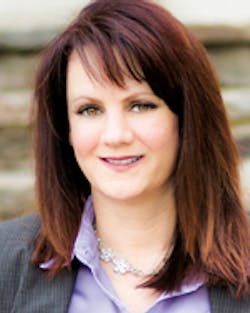Next generation sequencing paired with data analysis provides accurate pathogen identification
Professional:
I was recruited as the founding Chief
Executive Officer of Aperiomics in March 2014. Prior to that, I was President and Chief Science Officer for Phthisis Diagnostics, where I was a co-founder and led the company and its research program until it was acquired in 2013. I also created a consulting firm, Icenhour Biotech, in January 2014.
Education:
I hold a PhD in Pathobiology and Molecular Medicine from the University of Cincinnati College of Medicine and a BS in Biology from the University of Tulsa. I was a Research Fellow at Mayo Clinic College of Medicine and Senior Research Fellow at Duke University Medical Center.
Personal:
Currently, I am the Vice Chair of VirginiaBio and will soon become the first female Chair of that organization. I spend time inspiring and empowering others to follow their dreams in the science world through mentorship.
If you were explaining Aperiomics to someone who is not familiar with the organization, how would you characterize its primary areas of expertise? We see Aperiomics as the intersection of high-tech and biotech. Our ultimate goal is to identify every bacteria, virus, fungus, and parasite from any sample from a single test. That sample can be plant material, blood or other bodily substance, water, soil, or other environmental material. We use a combination of next generation sequencing and our proprietary data analysis platform. And as of now, we are able to identify more than 16,000 unique microbial species in a single test!
What are the major categories of solutions that Aperiomics provides for its clinical laboratory customers? Simply put, we offer next generation sequencing paired with data analysis to provide accurate pathogen identification. This is offered as a service at present. Our three primary solutions are Absolute*ID (identification of discrete sets of microorganisms per client’s needs); Absolute*Biome (microbiome characterization of any sample—comprehensive list of all microorganisms detectable in a given sample); and Absolute*Discovery (identification of pathogens from any sample).
How do genomics and advanced informatics combine to enable accurate pathogen detection? The genomic sequencing provides a “genetic blueprint” of all microorganisms present in a sample. The informatics technology takes that raw data and makes sense of it, identifying any microorganisms and/or pathogens present.
Aperiomics uses an unbiased sequencing and genomic analysis approach to identify pathogens in a sample. How does that approach enhance pathogen discovery, including cases of unknown etiology, and pathogen surveillance? The unbiased sequencing captures DNA data from all detectable microorganisms in a sample, whether all these organisms are known or unknown. Then our informatics matches that raw data against all known sequenced microbial genomes. This enhances pathogen discovery because it does not require knowing what microbes are sought; the DNA is sequenced for everything in the sample. As long as there are similar microbes in our database (which includes more than 40,000 genomes to date), both known and unknown microbes can be identified. Pathogen surveillance is achieved through establishing a microbiome “benchmark” and then comparing new samples over time with that standard. These tools provide more microbial information about samples than any other method available.
Can you tell readers more about Aperiomics’ Absolute*NGS Pathogen Detection suite of products? What are their most useful applications in the clinical lab? Absolute*ID identifies up to 20 microbes in a single test, as defined by client’s specific needs. Any known, previously sequenced microbes can be defined as microbes of interest. Absolute*Biome provides a microbiome characterization of any sample and identifies all known microbes present in any sample in a single test. Absolute*Discovery identifies pathogens present in any sample and all known pathogens present in any sample in a single test.
Do you think multiplexed genomic testing is the wave of the future? Is it feasible for labs of any size, or will it be, going forward? Yes. Sequencing is the future of clinical testing for everything from cancers to metabolic conditions to infectious disease testing. As sequencing technology becomes faster, more robust, and less expensive, all labs will be able to perform sequencing. Aperiomics aims to provide complex data analysis that can be paired with these sequencing systems, eventually providing “sample in, answer out” capabilities.
What are the key drivers of its adoption? What are some of the challenges that adoption of this technology faces? There are three key drivers. First, existing methods are inadequate; up to 75 percent of infections are never diagnosed. Second, the overuse of antibiotics is partly fueled by the inability to properly diagnose, so we need better tools to identify the pathogen causing illness and then apply the proper intervention and minimize the creation of resistant pathogens. Third, we can make healthcare more effective and ensure better outcomes when the appropriate treatment can be applied quickly and decisively.
The primary challenges are turnaround time and cost, but both are rapidly changing as the underlying sequencing technology matures. Testing is getting faster, and the process is improving its cost structure. Of course, this cost should be weighed against the expense of inaccurate diagnoses, which may lead to misuse or overuse of antibiotics, longer hospital stays, and other consequences of not being able to effectively treat a disease that has not been diagnosed. Currently, this technology is best used in cases of unknown etiology and chronic diseases such as irritable bowel disease and fibromyalgia, both of which are suspected of having an infectious component, according to recent studies.
What recognition have you received for your work? Most recently, I was invited to participate in The White House Microbiome Initiative that began with a conference on the “Future of Microbiomes” hosted by the White House Office of Science and Technology Policy. Attendance was limited to approximately 200 government, academic, and private sector experts.
In April, we learned that Aperiomics was selected from among five finalists as the Health & Life Sciences Innovator of the Year by the Northern Virginia Chamber in their 2nd Annual Greater Washington Innovation Awards. Recently, Women in Technology announced Aperiomics and me as a finalist in their Women in Technology Award competition.
I have served as a Board member, Vice Chair and Chair of the National Postdoctoral Association and have been very active in several other organizations (Association for Molecular Pathology, American Society for Microbiology, VirginiaBio, Charlottesville Business Innovation Council, Women in BIO, Sigma XI). I have received the Kauffman Foundation’s Outstanding Postdoctoral Entrepreneur Award, The Center for Innovation GAP 50 Award, and the 40 Under 40 Award from MD+DI.


